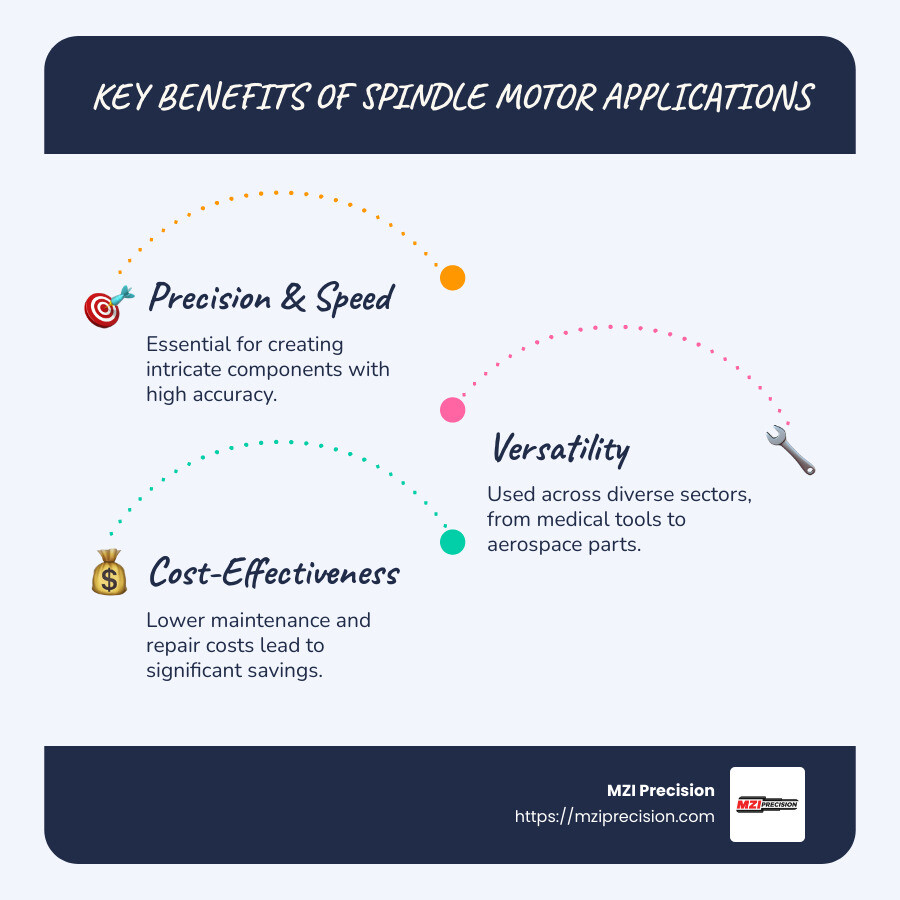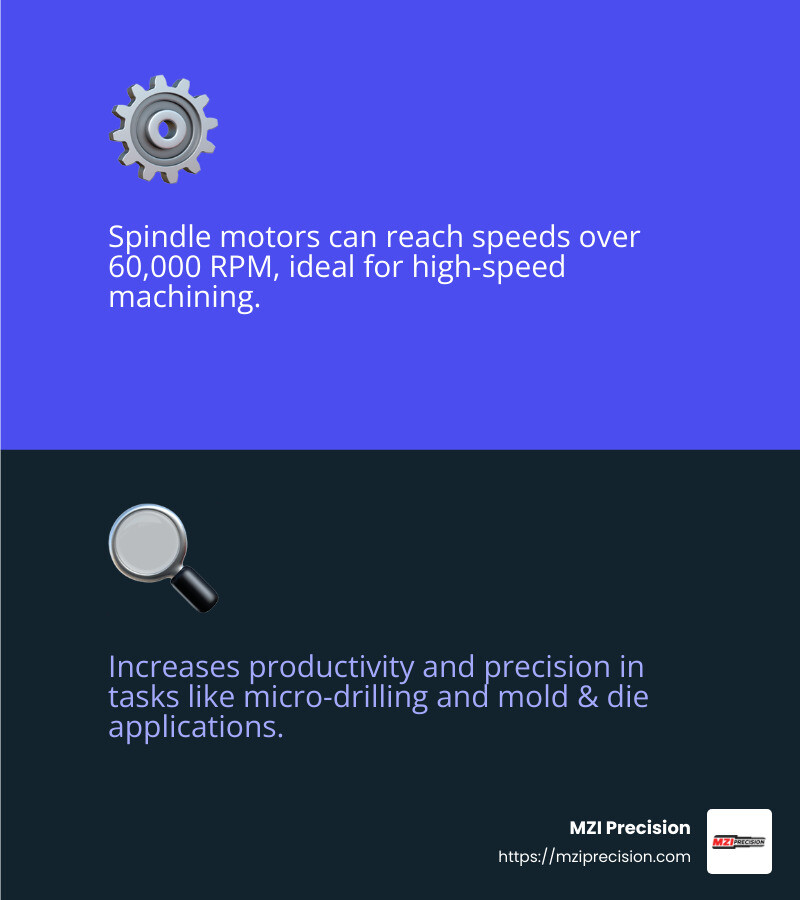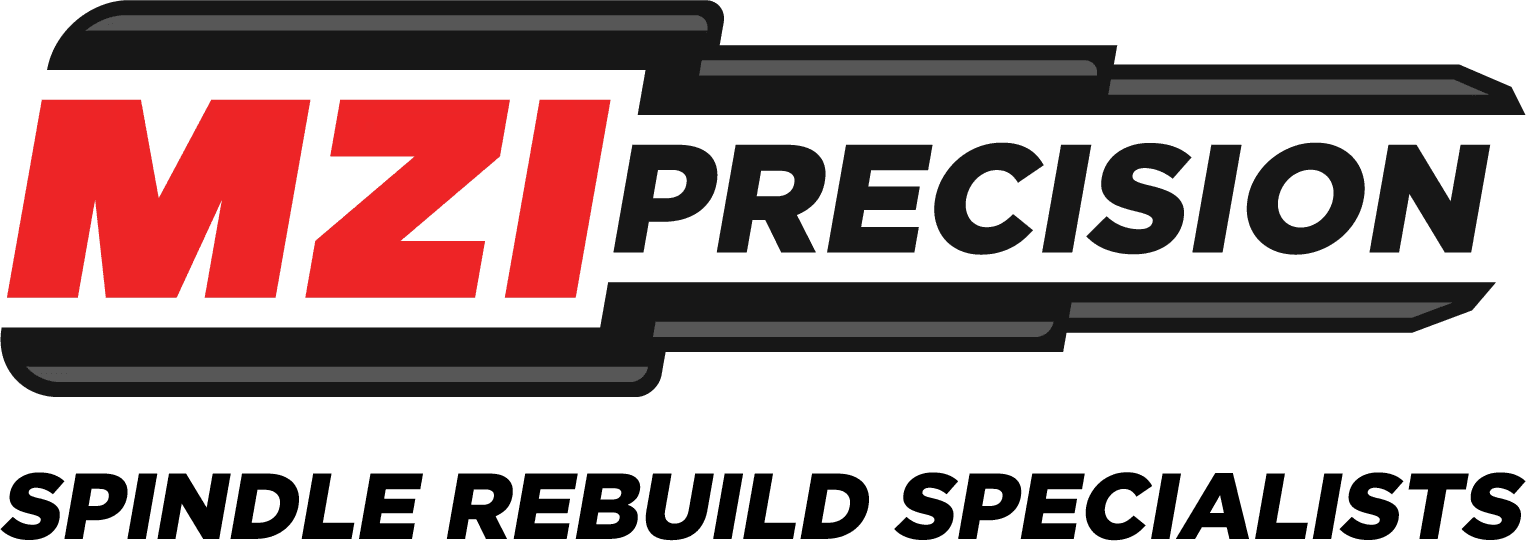Spindle motor applications are critical to the efficiency and precision of various industrial processes. These motors are the heartbeat of modern manufacturing machinery, offering the speed and accuracy needed in today’s competitive environment. Whether it’s in aerospace, medical device production, or heavy machinery manufacturing, spindle motors ensure high-quality outcomes.
- Precision and speed: Essential for creating intricate components with high accuracy.
- Versatility: Used across diverse sectors, from medical tools to aerospace parts.
- Cost-effectiveness: Lower maintenance and repair costs lead to significant savings.
- Improved productivity: Capable of high-speed operations to accelerate production times.
Spindle motors are not just components; they are the driving force behind advanced manufacturing, shaping the future of industries with their remarkable capabilities.

Spindle motor applications word list:
– spindle motors
– cnc machine spindle
– high speed spindle motor
Understanding Spindle Motors
Spindle motors are the powerhouse of CNC machines, converting electrical energy into mechanical motion. This change is vital for driving tools that cut, drill, and shape materials with precision.
Key Components
Let’s break down the essential parts that make spindle motors so effective:
1. Spindle Shaft
The spindle shaft is the central axis around which everything revolves. It holds the cutting tool or workpiece securely in place. Its strength and precision are crucial for maintaining accuracy during high-speed operations.
2. Spindle Bearings
Bearings are the unsung heroes of spindle motors. They ensure smooth and precise rotation by minimizing friction. High-quality bearings are essential for reducing wear and tear, leading to longer motor life and better performance.
3. Tool Interface
This is where the cutting tool connects to the spindle motor. A robust tool interface ensures that the tool remains stable during machining, which is critical for achieving precision and repeatability in industrial applications.
4. Drive Mechanism
The drive mechanism transfers power from the motor to the spindle shaft. This can involve pulleys, belts, gears, or direct drive systems. Each type has its pros and cons, but all aim to deliver consistent and efficient power transfer.
5. Cooling System
High-speed operations generate heat, which can affect performance. A cooling system, often involving fans or liquid cooling, helps manage this heat, ensuring the spindle motor operates within optimal temperature ranges.
6. Spindle Housing
The spindle housing is the protective shell that holds all these components together. It provides structural integrity, ensuring stability during machining. Think of it as the sturdy frame of a car, holding everything in place.
Rotational Motion and Energy Conversion
At the heart of spindle motors is the conversion of electrical energy into mechanical motion. This is achieved through the rotor and stator. The stator remains stationary, creating a magnetic field when electricity flows through it. This magnetic field interacts with the rotor, causing it to rotate. This rotation drives the spindle shaft, enabling the cutting tool to perform its tasks with precision.
Understanding these key components and how they work together is crucial for anyone involved in industrial manufacturing. Spindle motors are not just about power; they’re about precision, efficiency, and reliability, making them indispensable in modern manufacturing processes.
Spindle Motor Applications in Industrial Manufacturing
Spindle motors are essential in industrial manufacturing, especially for tasks requiring high precision and efficiency. Let’s explore how these motors are changing various industries, from aerospace to medical devices.
High-Speed Applications
High-speed machining is a game-changer, allowing manufacturers to complete tasks faster without sacrificing quality. Spindle motors can reach speeds over 60,000 RPM, making them ideal for applications like micro-drilling and mold & die finishing.
- Micro-Drilling: In industries such as medical and electronics, creating tiny, precise holes is crucial. High-speed spindles excel here, offering exceptional accuracy and speed. For example, in the medical field, these motors help produce intricate surgical instruments and implants with precision.
- Mold & Die Applications: High-speed spindles provide superior surface finishes, reducing the need for manual polishing. This not only saves time but also improves the quality of molds used in manufacturing processes.

Precision and Efficiency
Precision and efficiency are at the heart of spindle motor applications in industrial settings. These motors are designed to deliver high torque and speed control, ensuring low vibration and repeatability.
- High Torque and Speed Control: Spindle motors offer precise control over torque and speed, essential for applications requiring exact specifications. This control helps in maintaining consistent quality across production runs.
- Low Vibration and Repeatability: Minimizing vibration is critical in achieving high-quality finishes and extending tool life. The precision engineering of spindle motors ensures that vibration is kept to a minimum, resulting in repeatable and reliable performance.
In the aerospace industry, for instance, spindle motors are used to manufacture components that demand extreme accuracy and reliability. From engine parts to control mechanisms, these motors ensure that every piece meets the stringent standards required in aerospace manufacturing.
In summary, spindle motors are vital to industrial manufacturing due to their ability to combine high-speed capabilities with precision and efficiency. They are indispensable tools in sectors where quality, accuracy, and productivity are paramount.
Next, let’s dig into how to choose the right spindle motor for your specific needs.
Choosing the Right Spindle Motor
Selecting the right spindle motor is crucial for optimizing performance in industrial manufacturing. Different applications require different motor characteristics. Here’s what you need to know:
Types of Spindle Motors
AC Motors: AC induction motors are known for their ruggedness and reliability. They use alternating current to create a rotating magnetic field, which induces the rotor to spin. These motors are perfect for heavy-duty applications where high torque and continuous operation are needed. They are cost-effective and can handle significant loads, making them a popular choice in industries like metal cutting and drilling.
DC Motors: Unlike AC motors, DC motors use direct current and are often simpler in design. They offer good speed control, which is essential for applications requiring precise adjustments. However, they may not be as robust as AC motors for heavy-duty tasks.
Brushless DC Motors: These are the high-precision performers. They use permanent magnets in the rotor and electronic controllers to manage current flow, resulting in reduced friction and wear. This makes them more efficient and reliable, with an extended lifespan compared to traditional DC motors. Brushless DC motors are ideal for applications demanding precision and efficiency, such as in aerospace and medical device manufacturing.
Understanding Motor Characteristics
Torque vs. Horsepower: Torque is the rotational force the motor can exert, while horsepower is the rate at which work is done. In machining, torque is often more critical, especially when working with tough materials or larger cutting tools. High torque allows for effective material removal and is crucial for tasks that demand power and precision.
Spindle Speed: The speed of a spindle motor affects cutting results. Different materials and tools require specific speeds for optimal performance. For example, high-speed motors are essential for micro-drilling and mold & die applications, where precision and smooth finishes are crucial.
Spindle Size: The spindle size, or the diameter of the motor’s rotating shaft, impacts tool compatibility and stability. It’s important to match the spindle size to your machining needs to ensure rigidity and efficient power transmission. This alignment is vital for maintaining accuracy and quality in your manufacturing processes.
When choosing a spindle motor, consider your specific application requirements, such as the type of materials you’ll be working with and the precision needed. Consulting with experts or suppliers can also help in selecting the optimal motor type and specifications for your needs.
By understanding these key factors, you can make an informed decision that improves your manufacturing operations, ensuring both productivity and quality.
Next, we’ll address some frequently asked questions about spindle motors to further guide your selection process.
Frequently Asked Questions about Spindle Motors
How does a spindle motor work?
At the heart of a spindle motor are two vital components: the rotor and the stator. The stator is stationary and contains coils of wire. When electricity flows through these coils, it creates a magnetic field. This magnetic field interacts with the rotor, which is the spinning part of the motor. The interaction generates torque, causing the rotor to spin and drive the spindle. This spinning action is crucial for tasks like cutting, drilling, and milling in CNC machines. Precision bearings support the rotor’s smooth and high-speed rotation, ensuring accuracy in industrial applications.
What is the difference between a spindle motor and a servo motor?
Both spindle motors and servo motors are used in CNC machines, but they serve different functions.
- Spindle Motors: These are designed for high-speed rotation. They provide the power needed to turn cutting tools, focusing on delivering high torque and maintaining speed. This makes them ideal for operations that require continuous rotation, such as milling and drilling.
- Servo Motors: In contrast, servo motors are all about position control. They use feedback systems to adjust and correct their position, speed, and acceleration. This makes them perfect for tasks that require precise movement, like robotic arms in manufacturing.
The main differences lie in their purpose: spindle motors deliver rotational power, while servo motors excel in precision and control.
Is a spindle motor AC or DC?
Spindle motors can be either AC or DC, and the choice depends on the specific application and requirements.
- AC Induction Motors: These are robust and reliable, using alternating current to create a rotating magnetic field. They are well-suited for heavy-duty applications where durability and high power levels are needed. Common in industries like metal cutting, AC motors can handle continuous operation with ease.
- Brushless DC Motors: These motors use direct current and are known for their efficiency and precision. They use permanent magnets and electronic controllers to manage current flow, resulting in less friction and wear. This makes them ideal for high-precision applications, such as in aerospace and medical device manufacturing.
Choosing between AC and DC spindle motors depends on the balance between power, precision, and the specific demands of the task at hand. Each type offers unique advantages custom to different industrial manufacturing needs.
Conclusion
At MZI Precision, we understand that spindle motors are the beating heart of industrial machinery. They ensure precision, power, and efficiency in various applications, from aerospace to medical device manufacturing. We specialize in spindle repair and rebuilding, offering exceptional service and support to keep your operations running smoothly.
Our expertise in OEM spindle rebuilds sets us apart. We focus on restoring your machinery to peak performance, minimizing downtime, and maximizing productivity. With our skilled technicians and engineers, we handle repairs and maintenance with the utmost precision and care. Whether it’s high-speed spindles or motors requiring specific torque adjustments, we have the knowledge and tools to get the job done right.
Our commitment to exceptional service means we are with you every step of the way. From selecting the right spindle motor to maintaining and repairing it, we ensure your equipment operates at its best. We offer rapid turnaround times because we recognize that every moment of downtime is costly.
If you notice unusual noises, excessive vibration, or decreased performance in your spindle motors, it’s time to reach out to us. Early identification of issues can prevent expensive downtime and extend the life of your CNC machines.
Trust MZI Precision to keep your machinery operating at its best. Explore our full range of services and find how we can improve the performance and reliability of your machinery. Visit our Spindle Motors page to learn more and get started with us today.



